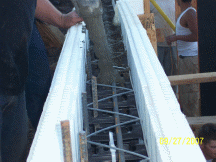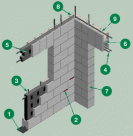The development of humanity is associated with permanently growing volumes of construction. People require residential and business buildings, and concrete is one of the most widely used construction materials on Earth. Gambhir (2004) argues that concrete is the second most popular substance in the world after water (p. 1). Therefore, a more detailed analysis of concrete should be taken to realize its pros and cons for construction purposes.
First of all, concrete is a mixture of “cementitious materials, water, and aggregates” (Gambhir, 2004, p. 1; Allen and Iano, 2009, p. 469). This fact explains the first advantage of concrete, i. e. the fact that it acquires firmness with time, as water and cementitious materials react with each other at a long-time scale, which changes the structure of concrete. In addition, concrete construction is time- and cost-effective promises easy maintenance and quick repair (Pratt, 2003, p. 42).
At the same time, concrete as a construction material displays several disadvantages. First of all, concrete is subject to corrosion as a result of seawater penetration or activities of natural or artificial chemicals (Gambhir, 2004, pp. 167 – 168). Second, concrete cracks after a certain period of time, which is explained by concrete drying (Allen and Iano, 2009, p. 470). Finally, concrete construction is often subject to planning errors, especially concerning per-cast concrete, which is associated with the nature of this construction material (Sacks et al., 2006, p. 47).
Further on, the processes of forming and casting concrete usually pose difficulties for constructors. This is explained by the fact that concrete is usually delivered to the construction site in a liquid pre-cast condition and requires proper forming, predominantly insulated to be carried out (Gambhir, 2004, p. 288; Sacks et al., 2006, p. 49). The process of concrete forming and casting can be illustrated as follows (Pic. 1):

In a schematic way, the process of insulated concrete forming and casting can be illustrated by Pic. 2:

Accordingly, the building and assembly processes that involve the use of concrete as a major construction material should be based on three main elements. The first two include the proper practices for concrete forming and casting, while the remaining one is the proper planning process that might involve either traditional paper planning or software planning approach as argued by Sacks et al. (2006, p. 53).
Finally, concrete as a construction material is associated with relatively high sustainability levels. As defined by Gambhir (2004), sustainability in construction is the attention paid to environmental issues, as well as problems of energy efficiency, materials conservation, and assurance of safety at the constructions sites and living areas (p. 7). Accordingly, the use of concrete provides opportunities for following all the above-listed concepts. Concrete construction is associated with little or no waste and is rather cost-efficient and environmentally friendly.
Thus, the conclusion of the above presented brief discussion is that concrete as a construction material has its pros and cons. The former includes considerable cost-efficiency, firmness, and sustainability, while the latter concern mainly the issues of concrete cracking and corrosions. However, the advantages of concrete construction obviously outweigh its disadvantages, which is illustrated by the fact that concrete is the material used for building purposes in the majority of cases.
Works Cited
Allen, Edward and Joseph Iano. Fundamentals of Building Construction: Materials and Methods, John Wiley and Sons, Inc. 2009, 5th Edition. Print.
Gambhir, Michael. Concrete technology. Tata McGraw-Hill, 2004. Print.
Pratt, David. Fundamentals of construction estimating. Cengage Learning, 2003. Print.
Sacks, Ronald et al. “Process Improvements in Precast Concrete Construction Using Topdown Parametric 3-D Computer Modeling.” PCI Journal 48.3 (2003): 46 – 55. Print.